Bridges
There are lots of bridges in Goole because of the flat land and the large number of river crossings. The largest bridge to dominate the skyline is the Ouse Bridge which carries the trans-Pennine M62 motorway between Liverpool towards Hull.
 M62 Ouse Bridge
M62 Ouse Bridge
The bridge was completed in the mid-1970s and resembles a huge Scalextric model. If you stop under the bridge along Westfield Banks, you can hear the rumble of thunder from the traffic in the sky above and there's a spooky echo if you shout. There is a panoramic view of Goole from the top of the bridge, along with Boothferry Bridge and the Humber Bridge if you know where to look. It has solar-powered navigation lights in the central piers.

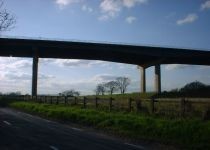

The Ouse Bridge was built to ease the congestion on Boothferry Bridge, which was built to replace an earlier ferry. From the days of "Booth's Ferry", this crossing point became increasingly important to travel and communication in the region and, with the demise of the Selby ferry, became the major crossing on the entire length of the River Ouse. It opened up the area to the north of the river and helped the growth of Howden. When the ferry ceased in 1929, it could claim to be the longest serving ferry on the Ouse and is forever remembered in the Ferryboat Inn nearby.
Boothferry Bridge was built to provide a more reliable way of crossing the river and was officially opened on 18 July 1929. It quickly became a traffic bottle-neck as the designers could not have anticipated the rapid growth in motor transport.
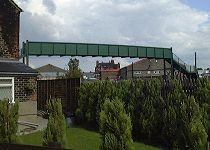
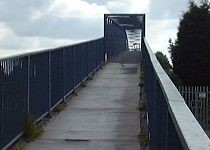
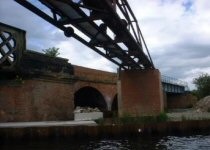
There are two footbridges across the railway, the Monkey Bridge off Gordon Street and Kingsway Bridge. The railway itself crosses the Dutch River, but the most famous bridge is Goole Railway Bridge at Hook. This is a huge iron bridge made of several spans and is notorious for getting struck by ships which struggle to navigate in the fast flowing Ouse.
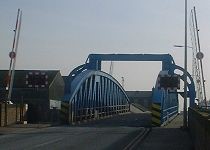
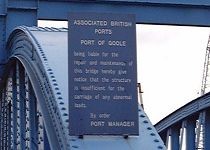
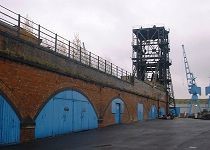
Bridge Street is the original name given to the road running through the heart of the docks. There are three bridges crossing West Dock, South Dock and the Dutch River. These bridges are notorious for slowing down the traffic because there are single-lanes, and when they close all traffic comes to a standstill. Although the bypass provides a detour around West Dock bridge, there is no alternative for the others unless the bypass is extended.
There was also a railway bridge across the road to carry coal wagons along a high-level line to a hoist. This was removed in the 1980s after the line was retired as it split the docks in two for high-side vehicles.

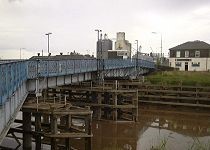
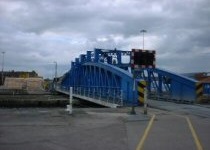
The Lowther Bridge crosses the docks at the top end of Aire Street. It was built around World War I and replaced an earlier bascule bridge.

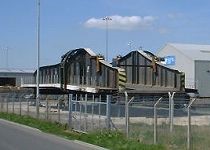
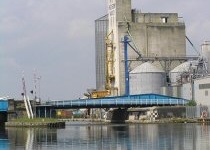
The South Dock bridge was recently replaced with a newer model. The new bridge was built by the side of the existing one and slid across with a huge floating crane over the space of a weekend. It allows two lanes of traffic to cross at once and was part of a more general modernising of all the bridge mechanisms. Instead of a man and a bike, the bridges are now controlled from one place and monitored with CCTV.
There were plans to preserve the original bridge, but these never happened. Instead the bridge has been abandoned and provides a sunshade for people fishing in South Dock.
The broad and tidal rivers that mark the northern frontiers of this area do not lend themselves to bridges. Until modern times the way out has been by ferry. In times past Whitgift Ferry was the most important with a long list of famous people from Charles I to John Wesley who have crossed there and a melancholy list of tragic drownings. The most dramatic of these happened in December 1614 when Sir John, Sir Edmund and Mr Philip Sheffield, sons of Edmund Lord Sheffield, Earl of Mulgrave and President of the Council of the North, with all their retinue were drowned at Whitgift Ferry. The 1906 Ordnance Survey records other ferries at Reedness, Swinefleet, Howden Dyke, Boothferry, Airmyn and Rawciffe. No doubt there were others.
Swinefleet Ferry was important too. Its great tragedy was on the 21st September, 1735 when, as Whitgift parish register tells us "The ferry boat at Swinefleet was overset with 15 persons on it, 14 of whom miserably perished in ye river". Since the development of Goole much the most important of these ferries was that to Booth - the Booth Ferry. Originally it belonged to the Bishop of Durham as Lord of Howden and those who ran it leased it from the reigning Bishop. In the tidying up of episcopal estates that took place after 1836, rather oddly, it came to belong to the Ecclesiastical Commissioners.
The great days of the Ferry seemed to end with the coming of the Railways. Up until then the Boothferry Inn had been famous nationwide for its hospitality and comfort. But the motor car brought traffic back to the roads and the Boothferry soon became again a very busy place. Indeed from 1888 onwards there had been a growing demand for a bridge. Building began in 1926 and the bridge - swing bridge, of course, because of the shipping - opened in July 1929. The final ferry crossed on 17 July 1929. Today the only ferry still in use - for pedestrians only and not available apparently to the general public - is that at Airmyn. Let it be treasured both for its continued practical usefulness and also as a surviving fragment of a nearly lost strand in our history.
The first bridge across the lower Aire was between Carlton and Snaith. It needed an Act of Parliament and, built in 1777 for £1,850 at the expense of Thomas Stapleton of Carlton Hall, it was a Toll Bridge. Though the reasons given for the bridge was "the importance of the flax trade to the area and the inadequacy of the ferry for the transport of bodies for burial in Snaith Churchyard", it looks as though it might really have been something of a commercial enterprise. As in those days ships had priority over roads it had to be a swing bridge. In 1928 because of the old bridge's "exorbitant tolls" and "total inadequacy for motor traffic", it was replaced by the present steel girder bridge. Much of the old bridge and its toll houses still remain. It is a great deal more beautiful than its replacement.
Horses (and mighty stagecoaches) can cross rivers by ferry. The last of the Aire railway bridges was built in 1912 for the Selby-Goole line between Rawcliffe and Newland. The line closed in 1964 and the bridge was demolished and only its be-graffitied supports remain. It is a scene of desolation. But the great and famous railway bridge is that across the Ouse near Goole. This was built with great difficulty in 1868 to carry the new line to Hull. When it was built it was one of the largest swing bridges in Europe and a great marvel.
The most beautiful of the bridges (actually the only beautiful bridge in the neighbourhood) is the magnificent new bridge that carries the M62 high above the Ouse at Hook. Begun in 1973 it was completed in 1976. The old rivers nearly won. Firm ground for the foundations was found with difficulty and the final cost was vastly greater than the estimates.
"Rivers, Rectors and Abbots", David Lunn - Bishop of Sheffield, 1990
Postcards

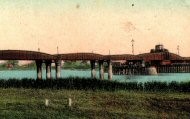

Visitor Comments
Posted by Rod on 09/06/2003
My uncle Doug (Doug Abbey) operated that bridge for many year after the war and after he retired from the Navy. He later became Harbour master at Goole Docks. I was probably down to him that you got stuck at the bridge so often!
Posted by Robert on 01/06/2005
There used to be a footbridge over the railway at the Stanhope Street end of Bridge Street for use by pedestrians when the railway gates that used to be there were closed to road traffic. There was also a footbridge between platforms at the station, and I suppose the Boothferry Road subways under the railway count as bridges too. The M62 brings several flyovers - if you look to your left at Rawcliffe as you approach Goole, you can see Rawcliffe Station below you (please do not try this if you are the driver). One of my favourites, though, has to be the "under and over" railway crossing between Rawcliffe and Gyme Corner.
Posted by Brian on 22/07/2005
For years when I was small we used to get stuck in the traffic crossing Boothferry Bridge and I always wanted us to get stopped at the front of the queue when the bridge opened for a ship. Then I remember the day before they opened the motorway bridge and everyone was walking across it - but not us because we had the caravan on the back and there was nowhere to park.
Posted by Robert on 02/09/2005
I remember the motorway bridge on the day before it opened. It was a pleasant evening, a Sunday I think, and there must have been several hundred people walked up to or across the bridge. I went with some friends and had just got to the middle when the police came and cleared everybody off. I've only ever driven across it since.
Posted by FH on 15/07/2005
Pickard's Bridge: this was a bridge within the docks, near to what was called the buzzer house. It allowed persons to pass from one side of the dock to the other.
Posted by Richard on 13/12/2005
In November 1973 the Boothferry Bridge was the scene of a huge traffic jam. A railway steam locomotive of class WD built by Vulcan Foundry in 1943 for the British Army had ended up in strategic store in Sweden. It was purchased by the Keighley & Worth Valley Railway at Haworth and was brought on a low loader lorry through Hull Docks. This load was so wide and heavy that all other traffic was stopped as it prepared to cross the bridge only to find that a couple of boats required the bridge to be swung. Eventually after something like two hours, the lorry and engine had crossed and traffic started rolling again. It was a bitterly cold day.
Posted by John on 14/01/2006
My grandad was the last ferryman and the first bridgeman at Boothferry and retired in 1964. His name was the same as his father's, John (Jack) Henry Robinson. We as a family spent many Sunday afternoons in the bridge control room, three longs and a short on a ship's horn would be the signal to open the bridge.
Posted by Bill on 04/06/2006
I remember that the Kingsway (pedestrian) Bridge was the place to try out your roller skates. In those days there were no "safety features" to get in the way. Brave souls would come down all the way from the top, I only managed half way. Terminal speeds were frightening and collisions with innocent oncoming pedestrians not unknown. It's a miracle we escaped without broken skulls.
Posted by David on 09/10/2006
The ferry at Booth was owned and operated by my great-grandfather who also had a pub at the same location. My grandfather was the youngest of six children, several of whom worked the ferry. The opening of the bridge put the ferry out of business but two of my great uncles (Jack and Harold) were employed as bridge keepers. The road over the bridge also bypassed the pub which didn't do much for the trade but I don't know when it closed. There was also a second ferry a little further downstream at Howdendyke. At low tide you can still see the remains of the slipways of both ferries that they used to get vehicles on and off.
Posted by Goolie on 12/11/2006
Ahh manya drunken nights on the monkey bridge back in the day LOL
Posted by Street Writer on 31/12/2006
Plenty of graffiti under the Ouse Bridge, ahhh lots of drunken nights there…
Posted by Clive on 11/02/2007
You have missed the railway bridges over the Dutch River and canal. I can see it from my bedroom window for the last 45 years.
Posted by Peter on 08/07/2007
As a former Old Goolie, not now living in Goole, I've not seen the new Dutch River bridge yet. Is it any better? Is Bridge Street still havoc? Any new safety measures along the stretch? That's one part of Goole not missed but I do miss the town.
Posted by Amanda on 13/07/2007
Could someone tell me how the "monkey bridge" got its name? I have asked my partner, who is originally from Goole and still has family there, and even he doesn't know!
Whenever we come through from Hull, we always go over Boothferry Bridge. I aren't too good with crossing bridges, and this one puts the fear of God in me.
Posted by Robert on 18/07/2007
It was called the "monkey bridge" at least as far back as the 1950s, but probably before. I've always assumed it was because of its design, the sides were made from metal strips in a diamond shape, like wire netting, so that people going across looked like climbing monkeys. I'm just guessing.
Posted by Bill on 04/08/2007
Indeed the "monkey bridge" was so named well before the 1940s. My mother was raised in Carter Street in the 1920s and she always referred to it by that name. I would love to know the origin of the name.
Posted by TMH on 17/02/2008
Having lived in Goole for most of my life, and played on the "monkey bridge" as a child, I have often wondered where it got its name from. Thanks from New South Wales.
Posted by John on 30/08/2008
As kids we used to cross it to go to school every day and we used to tie rope underneath to make a swing. This happened from it being built. The police used to chase us, if we were seen they called us little monkeys.
Needless to say, I got caught by local bobby. He chased me and clipped me around my ear for been cheeky. It hurt too, his hand was massive, wasn't cheeky to him again.
Posted by Anon on 13/01/2011
The monkey bridge crew lol
Posted by Amanda on 29/07/2007
I can't picture Lowther Bridge, we always use the bypass so don't know where it is. Is it true that each bridge was opened by a bloke on a bike? My partner told me this… I thought he was joking.
Posted by Ken on 31/10/2007
As a young lad I watched the Kingsway Bridge being erected. It was not without incident. Apart from a small fire, the centre section somehow got dropped and bent and had to be taken away for straightening, at Goole shipyard I heard. The brick built ramps are hollow inside and for a time we could crawl in there when the brickies went home - wonder if anyone is still inside?
It was the best runway for our pram-wheeled trollies on the Fountayne Street side. If you were good you could fly down the ramp from the top, shoot along the pavement and make a hard left at Kingsway, just miss the lamp post at the chicane, before flying over the kerb and onto Kingsway playing field. If you were not so good you either rolled it or hit the lamp post. Happy days.
Posted by Ray on 28/12/2014
The Kingsway pedestrian bridge collapsed onto the railway line when Goole Council Engineers tried to put it up, because they attempted to lift the entire span in one piece, which it was not designed for. The bolts holding two of the sections together failed, and the bridge had some minor damage, which had to be repaired, before another and more careful attempt at putting it up could be made, some weeks later. (This account is according to a Council Engineer, who told me the story).
Posted by Sam on 18/12/2009
I was born in Old Goole. I spent many hours waiting for the pea lorries to slow down for the Dutch River bridge and then run alongside and nick peas from them. I was also once daft enough to swing under the bridge as a dare on a small tube that ran from one side to the other. It doesn't bear thinking about now.
Posted by Robert on 14/08/2011
East Riding Archives at Beverley Library has a census of vehicles using Boothferry Bridge for the whole of the week beginning 10 February, 1930 (reference POL 3/6/5/70), little more than six months after the bridge opened. It includes the date and time, the name of the vehicle owner and the destination. There was more traffic than you might expect, possibly over 100 pages.
It is fascinating to note lots of local names, e.g. Easthams, Storrs, Pigeon Sykes motor bus from Swinefleet, Dr Wigglesworth from Howden, and (what I went to look for) Foster and Tetley's clothiers en route to Blacktoft on the Monday and Broomfleet on the Tuesday. There was some long distance traffic too. The archives also have later 1930s censuses, but I only had time to look through the February 1930 document. The others do not appear to list the owner's details.
Posted by Andrew on 08/11/2011
Working as a maintenance fitter on the docks in the early-1980s, one of our weekly tasks was to service West Dock, South Dock and Lowther bridges on a Thursday. This involved opening the bridge during the service to undertake maintenance work. I remember a boy stood on the footpath behind the lowered barriers commenting on the absence of a ship during such an event, only to be told by my colleague, Mr Dick Taylor, that a submarine was passing through and to look closely for the periscope. The lad's face was a picture and still makes me laugh all these years later.
Posted by Bill on 27/01/2013
Just to the east of Kingsway Bridge and next to the railway line there is/was a small rubbish dump which we called the "delf". There is a path to it between the allotments. Curious as to why it was so called. Anybody know?
Posted by Corby on 28/01/2013
There were three delfs and three dykes/ditches. The first dyke ran the whole length of Malvern Road. The second was between the two crossings that existed before the bridge was built. The first crossing linked Malvern and Limetree. The second crossing led to Hook Road by what everyone then called Mad Dog Lane, which now has a different location. The third dyke stopped at the cattle arch in Cowlings field. The dykes drained the railway embankments but fed the delfs which held the surplus water and became reed beds. A great place for kids for the abundance of wildlife.
Posted by Bill on 28/01/2013
Thanks for that very interesting bit of info - how on earth did you know that? I was wondering about the origin of the word delf, it sounds a bit Dutch but apparently it's an Old English word meaning a quarry. Could it have stayed in the folk memory from Old English/Viking times?
Posted by Keith on 28/01/2013
The delfs and dykes at the Malvern Road end also had an abundance of newts and sticklebacks, which as kids we would catch in our nets made from flour bags and pop them into a jam jar. Great times.
Posted by Corby on 28/01/2013
The creatures we caught had local names. The Great Crested Newt was known as an Astrid. There was also a fish about the size of a stickleback which was known as a Black Doctor. Black above and golden underbelly. I have never located this fish in books. Was it local to the area? Fishing and egg collecting was a passion back in those days - almost 70 years ago in my case.
Posted by Bill on 28/01/2013
Yes, catching newts and stickle bats in the dyke between Kingsway Bridge and the cattle arch was a favourite pastime. Last time I looked, about ten years ago, the ditch seemed to be entirely filled in - don't they need drainage anymore? When slightly older we used to go along there and roam around the delf with air rifles trying to shoot rats - but we never succeeded. Amazing that we could walk back home along the street toting an air rifle and nobody thought anything of it.
Posted by Keith on 28/01/2013
You're quite right, the black doctor and the redbreast were it seems local to this area. I too have never see them in any reference book. Don't forget the catties (catapult) - these were the days when kids could roam and parents need not worry!
Posted by Mark on 29/01/2013
This site brings back so many memories. I remember the cattle arch and the dump. I once lobbed a broken toy and caught my dad on the head by accident! I believe there was a bottle dump not far away? I broke loads to get the marbles out. If only I knew at the time they'd be worth a small fortune. I also caught newts in the dyke behind our house on Malvern Road. Never saw any rats though, thank god. We used to swing on a rope tied under Kingsway bridge and dared each other to swing out across the tracks as the trains came along. There used to be garages near the bridge and a building site (playground to us) just beyond those garages.
Posted by Phil on 17/08/2014
I'm now in my ninth decade (born 1928). I was delighted to see references to the delf. I often got my feet wet there in the company of George Turnbull, Les Kellet and Les Mitchell. While crossing the railway from Kingsway to go to Westfield Avenue where uncle Alf Abrey lived, there was a big field with a large greenhouse full of tomatoes. If you hung around long enough when the tomatoes were being picked they'd sometimes give you a big tomato to clear off. Oh, happy days!
Posted by Ray on 28/12/2014
Boothferry Bridge had a very embarrassing first time opening ceremony. It was a hot day, the bridge designers had not correctly calculated how much the bridge would expand, and the bridge simply jammed in the heat at the Goole end, and simply would not open. End of ceremony. The nearest "expert" who knew a bit (a lot) about expansion of large steel structures was the Assistant Superintendent of Goole Shipyard - my grandad. He turned up, examined the problem, and said "You need to cut six inches off this end of the bridge". This was a massive task, but eventually was accomplished, and the bridge opened and shut regularly thereafter. Somewhere, I have a photo of my grandad, taken when he was called out to inspect the bridge.
I realise that some non-engineering folks may think that six inches "sounds an awful lot" but be advised that when the new road bridge over the River Severn was designed many years ago now, we had to cater for expansion and contraction of several feet between a very hot summer's days and the coldest imaginable winter's day. And yes, we did have to ensure that cars don't have to "fly through the air" for five or more feet on a cold winters day!
Posted by John on 30/03/2016
My father always told me he drove the first bus across the Boothferry Bridge at Howden in 1929. His name was Ken Harper, and he would have been 26 at the time.
Back to Table of Contents
feedback@goole-on-the-web.org.uk